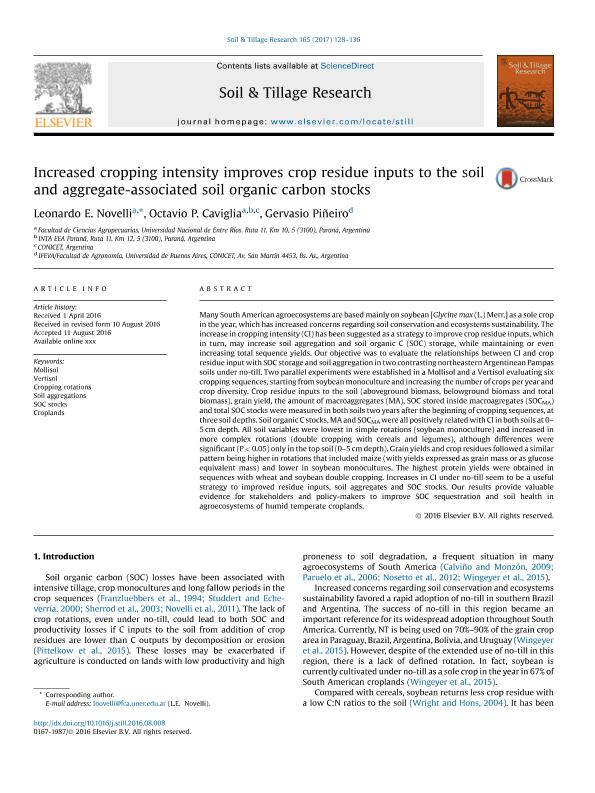Artículo
Increased cropping intensity improves crop residue inputs to the soil and aggregate-associated soil organic carbon stocks
Fecha de publicación:
01/2017
Editorial:
Elsevier Science
Revista:
Soil & Tillage Research
ISSN:
0167-1987
Idioma:
Inglés
Tipo de recurso:
Artículo publicado
Clasificación temática:
Resumen
Many South American agroecosystems are based mainly on soybean [Glycine max (L.) Merr.] as a sole crop in the year, which has increased concerns regarding soil conservation and ecosystems sustainability. The increase in cropping intensity (CI) has been suggested as a strategy to improve crop residue inputs, which in turn, may increase soil aggregation and soil organic C (SOC) storage, while maintaining or even increasing total sequence yields. Our objective was to evaluate the relationships between CI and crop residue input with SOC storage and soil aggregation in two contrasting northeastern Argentinean Pampas soils under no-till. Two parallel experiments were established in a Mollisol and a Vertisol evaluating six cropping sequences, starting from soybean monoculture and increasing the number of crops per year and crop diversity. Crop residue inputs to the soil (aboveground biomass, belowground biomass and total biomass), grain yield, the amount of macroaggregates (MA), SOC stored inside macroagregates (SOCMA) and total SOC stocks were measured in both soils two years after the beginning of cropping sequences, at three soil depths. Soil organic C stocks, MA and SOCMA were all positively related with CI in both soils at 0–5 cm depth. All soil variables were lowest in simple rotations (soybean monoculture) and increased in more complex rotations (double cropping with cereals and legumes), although differences were significant (P < 0.05) only in the top soil (0–5 cm depth). Grain yields and crop residues followed a similar pattern being higher in rotations that included maize (with yields expressed as grain mass or as glucose equivalent mass) and lower in soybean monocultures. The highest protein yields were obtained in sequences with wheat and soybean double cropping. Increases in CI under no-till seem to be a useful strategy to improved residue inputs, soil aggregates and SOC stocks. Our results provide valuable evidence for stakeholders and policy-makers to improve SOC sequestration and soil health in agroecosystems of humid temperate croplands.
Palabras clave:
Mollisol
,
Vertisol
,
Rotations
,
Aggregation
Archivos asociados
Licencia
Identificadores
Colecciones
Articulos(IFEVA)
Articulos de INST.D/INV.FISIOLOGICAS Y ECO.VINCULADAS A L/AGRIC
Articulos de INST.D/INV.FISIOLOGICAS Y ECO.VINCULADAS A L/AGRIC
Articulos(SEDE CENTRAL)
Articulos de SEDE CENTRAL
Articulos de SEDE CENTRAL
Citación
Novelli, Leonardo Esteban; Caviglia, Octavio Pedro; Piñeiro, Gervasio; Increased cropping intensity improves crop residue inputs to the soil and aggregate-associated soil organic carbon stocks; Elsevier Science; Soil & Tillage Research; 165; 1-2017; 128-136
Compartir
Altmétricas




